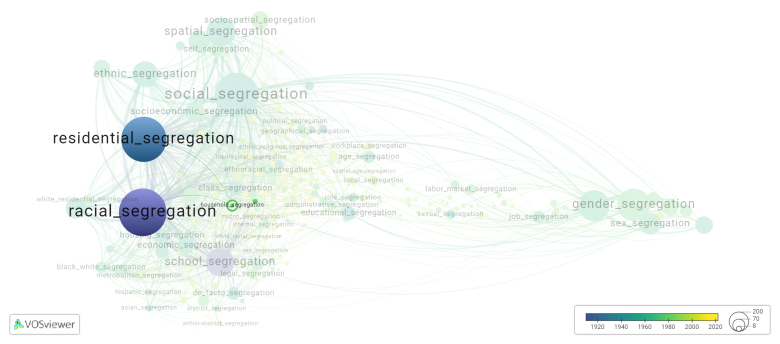Household segregation: Difference between revisions
(Creating page) |
(Creating page) |
||
| Line 17: | Line 17: | ||
white household segregation | white household segregation | ||
[[File:household_segregation.png|780x780px]] | [[File:household_segregation.png|780x780px]] | ||
For the complete network of associated segregation forms, see: | |||
clusters https://tinyurl.com/2d8wg5n3 | |||
year of publication https://tinyurl.com/2235lkhw | For the complete network of associated segregation forms, see: | ||
betweenness centrality https://tinyurl.com/223udk5r | |||
disciplines where segregation forms first appeared https://tinyurl.com/244d8unz | clusters https://tinyurl.com/2d8wg5n3 | ||
year of publication https://tinyurl.com/2235lkhw | |||
betweenness centrality https://tinyurl.com/223udk5r | |||
disciplines where segregation forms first appeared https://tinyurl.com/244d8unz | |||
==References== | ==References== | ||
==Notes== | ==Notes== | ||
Revision as of 07:46, 26 September 2024
Date and country of first publication[1]
1990
United States
Definition
Household segregation refers to the separation of different socioeconomic groups or demographic groups within a community or neighborhood. This can include racial, ethnic, or income-based segregation.
Household segregation can occur for various reasons, including social and economic factors. Historical and discriminatory practices, such as redlining, have contributed to racial and ethnic segregation in many cities. Economic disparities can also lead to income-based segregation, with wealthier households tending to live in more affluent neighborhoods while lower-income households are concentrated in lower-income areas.
The consequences of household segregation can be significant. Segregated neighborhoods often have limited access to quality education, healthcare, and other resources and amenities. This can perpetuate and worsen socio-economic inequalities. Segregated communities might also lack diversity, leading to limited exposure to different cultures and perspectives.
Efforts to address household segregation often involve policies aimed at promoting housing affordability, fair housing practices, and equitable access to resources and opportunities. Additionally, community-building initiatives, efforts to reduce economic disparities, and promoting diverse and inclusive neighborhoods contribute to reducing household segregation.
See also
Related segregation forms
Household segregation is frequently discussed in the literature with the following segregation forms:
For the complete network of associated segregation forms, see:
clusters https://tinyurl.com/2d8wg5n3
year of publication https://tinyurl.com/2235lkhw
betweenness centrality https://tinyurl.com/223udk5r
disciplines where segregation forms first appeared https://tinyurl.com/244d8unz
References
Notes
- ↑ Date and country of first publication as informed by the Scopus database (December 2023).
At its current state, this definition has been generated by a Large Language Model (LLM) so far without review by an independent researcher or a member of the curating team of segregation experts that keep the Segregation Wiki online. While we strive for accuracy, we cannot guarantee its reliability, completeness and timeliness. Please use this content with caution and verify information as needed. Also, feel free to improve on the definition as you see fit, including the use of references and other informational resources. We value your input in enhancing the quality and accuracy of the definitions of segregation forms collectively offered in the Segregation Wiki ©.
Household segregation appears in the following literature
Miller V.P., Quigley J.M. (199). Segregation by Racial and Demographic Group: Evidence from the San Francisco Bay Area. Urban Studies, 27(1), 3-21. https://doi.org/10.1080/00420989020080011
Grodzińska-Jurczak M., Tomal P., Tarabuła-Fiertak M., Nieszporek K., Read A.D. (2006). Effects of an educational campaign on public environmental attitudes and behaviour in Poland. Resources, Conservation and Recycling, 46(2), 182-197. https://doi.org/10.1016/j.resconrec.2005.06.010
Marsh K., Iceland J. (201). The racial residential segregation of black single living alone households. City and Community, 9(3), 299-319. https://doi.org/10.1111/j.1540-6040.2010.01338.x
Fischer M.J. (2013). Black and white homebuyer, homeowner, and household segregation in the United States, 1990 2010. Social Science Research, 42(6), 1726-1736. https://doi.org/10.1016/j.ssresearch.2013.07.015
Fischer M.J. (2013). Black and white homebuyer, homeowner, and household segregation in the United States, 1990 2010. Social Science Research, 42(6), 1726-1736. https://doi.org/10.1016/j.ssresearch.2013.07.015

